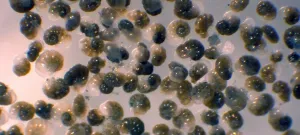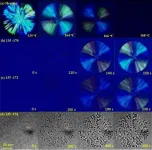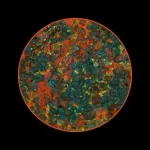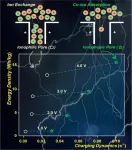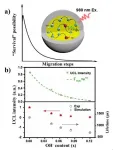Quark-gluon plasma flows like water, according to new study
2021-05-27
(Press-News.org) What does quark-gluon plasma - the hot soup of elementary particles formed a few microseconds after the Big Bang - have in common with tap water? Scientists say it's the way it flows.
A new study, published today in the journal SciPost Physics, has highlighted the surprising similarities between quark-gluon plasma, the first matter thought to have filled the early Universe, and water that comes from our tap.
The ratio between the viscosity of a fluid, the measure of how runny it is, and its density, decides how it flows. Whilst both the viscosity and density of quark-gluon plasma are about 16 orders of magnitude larger than in water, the researchers found that the ratio between the viscosity and density of the two types of fluids are the same. This suggests that one of the most exotic states of matter known to exist in our universe would flow out of your tap in much the same way as water.
The matter that makes up our Universe is made of atoms, which consist of nuclei with orbiting electrons. Nuclei consist of protons and neutrons known collectively as nucleons and these in turn consist of quarks interacting via gluons. At very high temperatures - about one million times hotter than the centre of the Sun- quarks and gluons break free from their parent nucleons and instead form a dense, hot soup known as quark-gluon plasma.
It is thought that shortly after the Big Bang the early universe was filled with incredibly hot quark gluon plasma. This then cooled microseconds later to form the building blocks of all the matter found within our universe. Since the early 2000s scientists have been able to recreate quark-gluon plasma experimentally using large particle colliders, which has provided new insights into this exotic state of matter.
The ordinary matter we encounter on a daily basis are thought to have very different properties to the quark-gluon plasma found in the early beginnings of the Universe. For example, fluids like water are governed by the behaviour of atoms and molecules that are much larger than the particles found in quark-gluon plasma, and are held together by weaker forces.
However, the recent study shows that despite these differences the ratio of viscosity and density, known as the kinematic viscosity, is close in both quark-gluon plasma and ordinary liquids. This ratio is important because the fluid flow does not depend on viscosity alone but is governed by the Navier-Stokes equation which contains density and viscosity. Therefore, if this ratio is the same for two different fluids these two fluids will flow in the same way even if they have very different viscosities and densities.
Importantly, it's not just any liquid viscosity that coincides with the viscosity of quark-gluon plasma. Indeed, liquid viscosity can vary by many orders of magnitude depending on temperature. However, there is one very particular point where liquid viscosity has a nearly-universal lower limit. Previous research found that in that limit, fluid viscosity is governed by fundamental physical constants such as the Planck constant and the nucleon mass. It is these constants of nature that ultimately decide whether a proton is a stable particle, and govern processes like nuclear synthesis in stars and the creation of essential biochemical elements needed for life. The recent study found that it is this universal lower limit of viscosity of ordinary fluids like water which turns out to be close to the viscosity of quark-gluon plasma.
Professor Kostya Trachenko, Professor of Physics at Queen Mary University of London and author of the recent paper, said: "We do not fully understand the origin of this striking similarity yet but we think it could be related to the fundamental physical constants which set both the universal lower limit of viscosity for both ordinary liquids and quark-gluon plasma."
"This study provides a fairly rare and delightful example of where we can draw quantitative comparisons between hugely disparate systems," continues Professor Matteo Baggioli from the Universidad Autónoma de Madrid. "Liquids are described by hydrodynamics, which leaves us with many open problems that are currently at the forefront of physics research. Our result shows the power of physics to translate general principles into specific predictions about complex properties such as liquid flow in exotic types of matter like quark-gluon plasma."
Understanding quark-gluon plasma and its flow is currently at the forefront of high-energy physics. Strong forces between quarks and gluons are described by quantum chromodynamics, one of the most comprehensive physical theories that exist. However whilst quantum chromodynamics provides a theory of strong nuclear force, it is very hard to solve and understand quark-gluon plasma properties using this alone.
"It is conceivable that the current result can provide us with a better understanding of the quark-gluon plasma," added Professor Vadim Brazhkin from the Russian Academy of Sciences. "The reason is that viscosity in liquids at their minimum corresponds to a very particular regime of liquid dynamics which we understood only recently. The similarity with the QGP suggests that particles in this exotic system move in the same way as in tap water."
INFORMATION:
Notes to editors
* Research publication: 'Similarity between the kinematic viscosity of quark-gluon plasma and liquids at the viscosity minimum' Matteo Baggioli, Vadim Brazhkin, Kostya Trachenko SciPost Physics DOI: 10.21468/SciPostPhys.10.5.118.
* A copy of the paper is available at: https://scipost.org/SciPostPhys.10.5.118
* For more information please contact:
Sophie McLachlan
Faculty Communications Manager (Science & Engineering)
Queen Mary University of London
sophie.mclachlan@qmul.ac.uk
Tel: 020 7882 3787
About Queen Mary
Queen Mary University of London is a research-intensive university that connects minds worldwide. A member of the prestigious Russell Group, we work across the humanities and social sciences, medicine and dentistry, and science and engineering, with inspirational teaching directly informed by our world-leading research. In the most recent Research Excellence Framework we were ranked 5th in the country for the proportion of research outputs that were world-leading or internationally excellent. We have over 25,000 students and offer more than 240 degree programmes. Our reputation for excellent teaching was rewarded with silver in the most recent Teaching Excellence Framework. Queen Mary has a proud and distinctive history built on four historic institutions stretching back to 1785 and beyond. Common to each of these institutions - the London Hospital Medical College, St Bartholomew's Medical College, Westfield College and Queen Mary College - was the vision to provide hope and opportunity for the less privileged or otherwise under-represented. Today, Queen Mary University of London remains true to that belief in opening the doors of opportunity for anyone with the potential to succeed and helping to build a future we can all be proud of.
ELSE PRESS RELEASES FROM THIS DATE:
2021-05-27
Woods Hole, Mass. (May 27, 2021) - With the expansion of oxygen-depleted waters in the oceans due to climate change, some species of foraminifera (forams, a type of protist or single-celled eukaryote) that thrive in those conditions could be big winners, biologically speaking.
A new paper that examines two foram species found that they demonstrated great metabolic versatility to flourish in hypoxic and anoxic sediments where there is little or no dissolved oxygen, inferring that the forams' contribution to the marine ecosystem will increase with the expansion of oxygen-depleted habitats.
In addition, the paper ...
2021-05-27
Twenty scientists from 14 countries warn of a hidden "pandemic within the pandemic" in two current publications. On the one hand, physical activity levels have gone down significantly, on the other hand, psychological well-being has suffered. "Governments and those responsible for health systems should take our findings seriously," emphasizes the author team, headed by Dr Jan Wilke from the Institute for Sport Sciences at Goethe University Frankfurt.
About 15,000 people in participating countries answered standardised questionaires as part of an international survey. In April/May 2020, they reported physical activity levels (13,500 participants) as well as their mental and physical well-being (15,000 participants) ...
2021-05-27
With global warming decreasing the size of New Zealand's alpine zone, a University of Otago study found out what this means for our altitude-loving kea.
The study, published in Molecular Ecology, analysed whole genome DNA data of the kea and, for the first time, its forest-adapted sister species, the kākā, to identify genomic differences which cause their habitat specialisations.
The researchers found the kea is not an alpine specialist, but rather one that adapted to using such an open habitat because it was least disturbed by human activity.
Co-author Associate Professor Michael Knapp, of the Department of Anatomy, says that is not likely to surprise people ...
2021-05-27
Different from small molecules, polymer will fold into lamellar crystals during crystallization and further assemble into lamellar stacks.
Synchrotron Small-Angle X-Ray Scattering (SAXS) is an important tool to characterize such nanoscale structure and understand polymer crystallization. However, its scattering mechanism in semi-crystalline polymers is not completely elucidated yet.
Recently, a research group led by Prof. TIAN Xingyou from Institute of Solid State Physics, Hefei Institutes of Physical Science (HFIPS), proposed a complete set of new methods to characterize polymer lamellar crystals ...
2021-05-27
Epithelial ovarian cancer (EOC) is the most common lethal gynaecological cancer. Ovarian cancer is usually treated with platinum-based chemotherapy; however, a significant number of patients are resistant to such treatments and relapse soon afterwards. To improve their survival, there is a need to first identify which patients may be platinum-resistant, so that newer treatments may be administered early.
Now, researchers from the Cancer Science Institute of Singapore (CSI Singapore) at the National University of Singapore (NUS), have discovered a way to predict which patients are resistant to platinum chemotherapy. The study, co-led by CSI Singapore Principal ...
2021-05-27
Current best practices for encouraging more female students to pursue degrees in economics may actually have the opposite effect and worsen gender disparities in the field, a recent study from Oregon State University found.
The study examined whether mass emails telling introductory economic students about promising career and earning opportunities helped increase female participation in higher-level economics courses. But instead, these emails appealed more to male students, increasing male enrollment and widening the existing gender gap. There was no change in the probability of female students majoring in economics.
Researchers say this demonstrates a need for more personalized, deliberate interventions.
"There ...
2021-05-27
Using renewable energy to replace fossil energy is now considered the best solution for greenhouse gas emission and air pollution problems. As a result, the demand for new and better energy storage technology is strong.
As part of the effort to improve this technology, a group led by Prof. ZHANG Suojiang from the Institute of Process Engineering (IPE) of the Chinese Academy of Sciences (CAS) recently found that ionophobic electrodes can boost energy storage performance.
Their study was published in the Journal of Materials Chemistry A on May 8.
Electric Double-Layer Capacitors (EDLCs) with ionic liquids (ILs)--as a new type of energy storage device--can fill the gap between the power density of batteries and the ...
2021-05-27
Human-driven global change is challenging the scientific community to understand how marine species might adapt to predicted environmental conditions in the near-future (e.g. hypoxia, ocean warming, and ocean acidification). The effects of the uptake of anthropogenic atmospheric CO2 by oceans affects (i.e. ocean acidification) propagate across the biological hierarchy, from changes in the building blocks of life at nano-scales to organism, physiology and behaviour through ecosystem processes and their properties.
To survive in a reduced pH environment, marine organisms have to adjust their physiology which, at the molecular level, is achieved by modifying the expression ...
2021-05-27
The great application prospect in biology, medicine, optogenetics, photovoltaics and sustainability has enabled lanthanide ions-doped upconversion nanoparticles to attract widespread attention which derives mainly from their superior anti-Stokes spectroscopic property. However, the relatively low upconversion efficiency remains a major bottleneck on their way of actual applications. Internal OH- impurity is known as one of the main detrimental factors affecting the upconversion efficiency of nanomaterials. Different from surface/ligand related emission quenching which can be effectively diminished by, e.g., core/shell structure, internal OH- is easy to be introduced during synthesis but difficult to be quantified and controlled.
In a new paper published in Light Science ...
2021-05-27
PHILADELPHIA--Antibodies aren't the only immune cells needed to fight off COVID-19 -- T cells are equally important and can step up to do the job when antibodies are depleted, suggests a new Penn Medicine study of blood cancer patients with COVID-19 published in Nature Medicine. The researchers found that blood cancer patients with COVID-19 who had higher CD8 T cells, many of whom had depleted antibodies from cancer treatments, were more than three times likelier to survive than patients with lower levels of CD8 T cells.
"It's clear T cells are critical in terms of the early infection and to help control the virus, but we also showed that they can compensate for B cell and antibody responses, which blood cancer patients are likely missing because of the drugs," said co-senior author Alexander ...
LAST 30 PRESS RELEASES:
[Press-News.org] Quark-gluon plasma flows like water, according to new study
